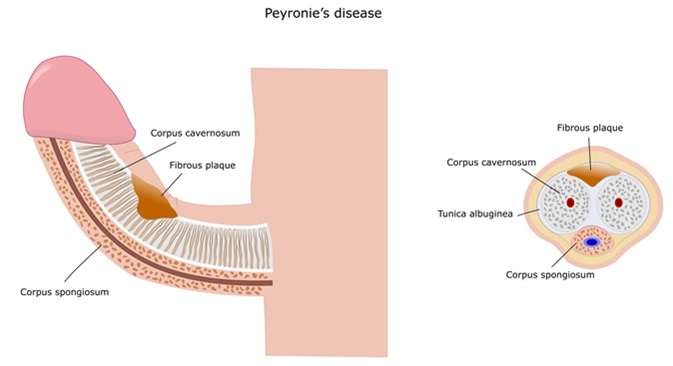It is a problem of abnormal bending of penis. In Peyronies disease the penis bends upwards or to the side. It is caused by plaque formation inside the penis. The actual reason for plague formation is not known but it may start in some cases with injury which causes bleeding inside the penis. In some cases it is genetic.
It mainly occurs in middle aged men, but can also be found in young and old aged males. Diabetics are more predisposed to Peyrnoiess Disease
Symptoms
- The symptoms appear slowly. In severe cases the plague hardens, one feels pain, obstructs flexibility and forces the penis to bend or arc when erected.
- In majority of the cases the pain goes away but the bend in the penis remains.
- In some cases the person develops scar tissues in a different part of the body, for example hands or foot.
- People with Dupuytren’s contractures — scarring in the hand that affects fingers are more likely to develop Peyronie’s Disease
- It can be associated with Erectile Dysfunction.
Diagnosis
- If a person experiences the above symptoms he must visit a doctor.
- The doctor would ask for details about past history, any type of injury that occurred before the symptoms started.
- The doctor may also examine the penis; he may have to erect the penis by injecting medication to study the condition.
- The doctor may also the person to get X-Ray or Doppler Ultrasound done of the penis.
Treatment
In most cases the pain improves on its own without any treatment. Doctors prefer to wait for one or two years before they try to correct it. If the problem is mild and if it is not causing any problem in the patients sex life then doctors generally do not advise any treatment.
But in severe cases doctors may go in for the following treatments:
- The doctor will prescribe medicines such as as pentoxifylline or potassium para-aminobenzoate (Potaba). Though the evidence for the same is poor
- If these medicines do not work; then the doctor will inject verapamil or collagenase (Xiaflex) into the scar tissue of the penis. Again it is not known to work in all cases
- If these two treatments do not work then the doctor might consider surgery as a treatment. Surgery is only taken into consideration if the condition is severe and the disease is hampering the sex life of the patient.
The two most common operations done in the surgery procedure are:
- Removing the plaque and getting a tissue graft in its place.
- Removing or altering the tissue on the side of the penis opposite the plaque, which counters the disease’s bending effect.
In some cases a penile prosthesis implanted. But this treatment is used only with patients who have both Peyronie’s disease and ED (erectile dysfunction).
Other ways that are used to treat Peyronie’s disease is injecting chemicals directly into the plaque and shock wave lithotripsy. They are rarely used as it only stops the pain the disease causes, and the pain in most of the cases goes away on its own.


Recent Comments